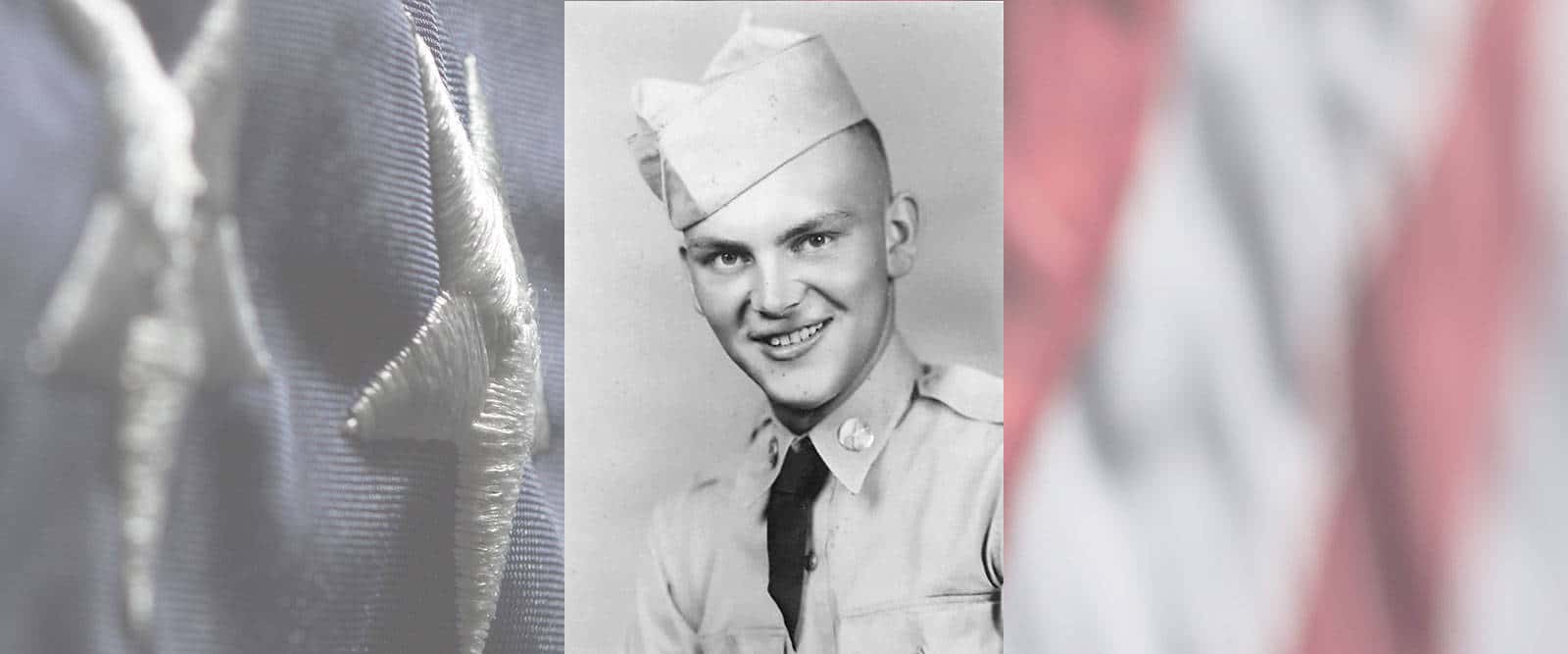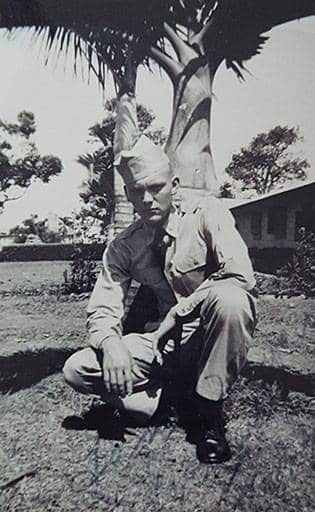U.S. Army Korean War Oregon, IL Flight date: 09/13/17
By David Koziol, Honor Flight Chicago Veteran Interviews Volunteer
George Owen was born in Minnesota in Dec 1934 and is proud of his Norwegian descent. He is the oldest of eight children; his five younger brothers all served in the military. The oldest three brothers served in the Air Force stateside during the Korean War while the two youngest served in the Army overseas, one in Korea after the Korean War Armistice and the youngest in Vietnam during the Vietnam War.
George’s mother remarried and the family moved a couple of times over the years. Their first family move was to Nebraska where George’s step-father worked for Martin Aircraft during WWII. Next, they moved to South Dakota, where George enlisted into the Army. Since he was only seventeen his mother had to give her permission. The recruitment officer promised them George would not be sent overseas until he was eighteen. In Feb 1952, his mother signed the recruitment papers and George was inducted into the Army.
George was sent to Illinois and was processed at Ft. Sheridan. He was then transferred to Schofield Barracks in Hawaii for basic training. He said, “The whole island of Oahu was practically a military base.” He trained in Hawaii for sixteen weeks in light weapons as a rifleman. After basic he was granted a short leave and was transferred to Japan as a “casual” member of the 7th Infantry Division, “casual” meaning he was not assigned to any specific unit. The promise of the recruitment officer was broken as George arrived in Japan.
George received more training in Japan, attending a couple of weeks of CBR (chemical/biological/radiological) school while stationed there. He would soon take the ferry crossing from Sasebo, Japan to Pusan, Korea in Oct 1952. “I’ve never been so sick in my life as I was on the ferry boat” George exclaimed. Not only was George still seventeen and overseas, he was now in the Korean war-zone.
George said, “I sat around in Pusan a few days” until he learned of his fate. He was still with a large group of men who had just been ferried to Pusan when they were asked who was assigned to the 31st Infantry Regiment. Half of the men said they were assigned and were loaded into trucks. The remaining half were told they were now members of the 31st Infantry Regiment and they too were loaded into trucks. The trucks headed to Regimental Headquarters where George was assigned to Company K, 3rd Battalion, 31st Infantry Regiment. He was told his new unit “was getting torn up” in the Triangle Hill area on the MLR (main line of resistance) and he was a much-needed replacement.
George was sent to the Triangle Hill area and initially assigned as a .30 caliber machine gun ammo-bearer in a rifle squad. A week later by attrition he was the machine gunner. His squad spent ten days in one of the forward outposts named Tom, Dick and Harry. These outposts were forty-five minutes in front of the MLR and only twenty minutes from the main Chinese/North Korean line. George said, “We would get a canteen of water a day, and the outpost was really miserable.” Luckily for George he was only assigned this forward outpost duty one time.
After a month in Korea, George was transferred to another rifle squad in Company K and became the squad leader. He was a Private (E-2) and did not receive any promotion, he said “The ranks were frozen.” So, as a Private he was leading nine to fifteen men, including three to six South Korean Army soldiers embedded in his squad. He did not mind the South Koreans stating, “They were bodies with rifles that could fill a spot.”
During his time on the MLR when he was not in that forward outpost, his squad “ran patrols into no man’s land during the night.” Sometimes he would lead his squad alone and sometimes his squad would group up with another squad or two and be led by a lieutenant. These patrols were dangerous because they occurred at night between the American and Chinese/North Korean lines. George also recalls having Thanksgiving dinner in Nov 1952 on the MLR.
Company K was pulled off the line after Thanksgiving and sent to the Army Corps reserve area. George and his squad got to sleep in tents with floors for about a month. He celebrated Christmas 1952 in the Army Corps reserve area. His commanding lieutenant then volunteered the platoon, which included George’s squad, to guard the railroad boxcars containing the Company K equipment in Seoul, Korea. George spent his 18th birthday, Dec. 27, 1952, “inside a boxcar” in Seoul.
In early January 1953, George would “enjoy” a two-day journey inside the boxcar from Seoul to a railhead where the company equipment was unloaded into trucks. The trucks then transported the platoon and equipment to Company HQ. George, who had finally been promoted to Private First Class, and Company K were now assigned the defense of Alligator Jaws Hill. They lived in trenches and bunkers and ran patrols a few times a month. By February 1953, they were on Pork Chop Hill and repelled a “light attack.” On Feb 18, 1953 George was again promoted, this time to Corporal. By March the patrol duties had stopped after “two American patrols had a fire fight.”
In April, Company K was pulled off Pork Chop Hill and placed behind the hill in a blocking position. By mid-April the Chinese attacked the remaining American positions on Pork Chop Hill, capturing it by overwhelming the defenders. Company K along with Company L were ordered to take back the hill. George said there “was very heaving fighting and I was only there for about six hours.” The Chinese were using the American trenches and trench covers as barricades. He said, “I was dodging Chinese grenades and throwing my grenades when I got hit in the leg with enemy grenade fragments.” George kept advancing and attacking the enemy until he saw something unusual. He said, “It looked like a kitten ball with rag streamers attached.” It exploded and “I was hit in the face blowing my helmet off.”
George, still suffering from a leg wound and now a facial wound, was evacuated off the hill. He was put in a stretcher and placed across the top of an armored personnel carrier and driven to an aid station. From the aid station, he was delivered to a MASH unit which George said, “was just like the one on television.” He was sent from the MASH unit to Inchon, Korea and then to an offshore hospital ship. There he says, “They removed most of the big pieces out of my head, I still have some in there.” They also removed the large pieces from his leg, George adds “I had tiny little holes all over me.”
Pork Chop Hill was a very costly battle, elements of the 31st Infantry and 7th Infantry Regiments took heavy casualties. By the end of May, George was almost healed and was sent back to Company HQ. He said, “I didn’t know anybody except for one sergeant when I got back.” With stitches remaining in his leg, he had to spend an additional three weeks on sick leave. After sick leave, he was told by the company clerk he had been unknowingly promoted to Staff Sergeant, ironically the day before he was wounded on Pork Chop Hill.
George had enough points to rotate home, but the Company K commanding officer asked him to be a platoon sergeant. He accepted and this company commander allowed George to wear his much better flak jacket out on patrol. So, it was another patrol into what George called “Death Valley.” During this first patrol George learned the #1 and #2 sergeant in line to rotate home were wounded. George was pulled off the line and was rotated home, as he was #3 on the list.
George was to travel from Korea by ship to Seattle, Washington, but instead the ship went to Tokyo, Japan. He got to spend the 4th of July there and enjoyed a much-deserved ten-day leave eating and drinking. He was finally shipped to Seattle from Tokyo and was given a thirty day leave upon arriving at Ft. Lewis, located just outside Seattle. He finally got to go home temporarily. During his thirty-day leave the Korean War Armistice was signed.
After his leave, he reported back to Ft. Lewis and was assigned as a platoon sergeant in a basic training company, many times as an acting Sergeant First Class. He also got to go to NCO school at Ft. Benning, Georgia and to Alaska for a couple of months during the winter of early 1954. In the summer of 1954, he trained with National Guard units in the Yakima Desert in Washington State. In February 1955, George was honorably discharged at Ft. Lewis. His service awards include the Purple Heart, National Defense Service Medal, Korean Service Medal w/3 Campaign Stars, United Nations Korean Service Medal, and the Republic of Korea War Service Medal. He also earned the Combat Infantry Badge and two Korean Presidential Unit Citations.
George returned to South Dakota and went to college studying biology on the GI Bill, and worked as a truck driver. He applied for a job in a Chicago biology lab and he landed that job. He worked at the biology lab until 1962 when he placed #1 on the Chicago Police Exam and was hired a police officer. He served thirty-two years with the CPD and retired a Sergeant in 1994.
During his time in Chicago, he met his wife Paulette and raised four children. They are George Jr., John, Roseann and Paula. His two sons are also Chicago Police Sergeants. George and his family first lived on the north side of Chicago then moved south to the Marquette Park neighborhood. After his retirement from the CPD George and Paulette moved to Oregon, Illinois to live. George now splits his time between the home in Oregon and his daughters’ home in Evergreen Park, Illinois since the passing of Paulette in 2009. George is a member of Oregon VFW Post #8739, and is a former post commander.
George, we thank you for your exceptional and heroic military service during the Korean War. Enjoy your much-deserved Honor Flight to Washington, D.C.





